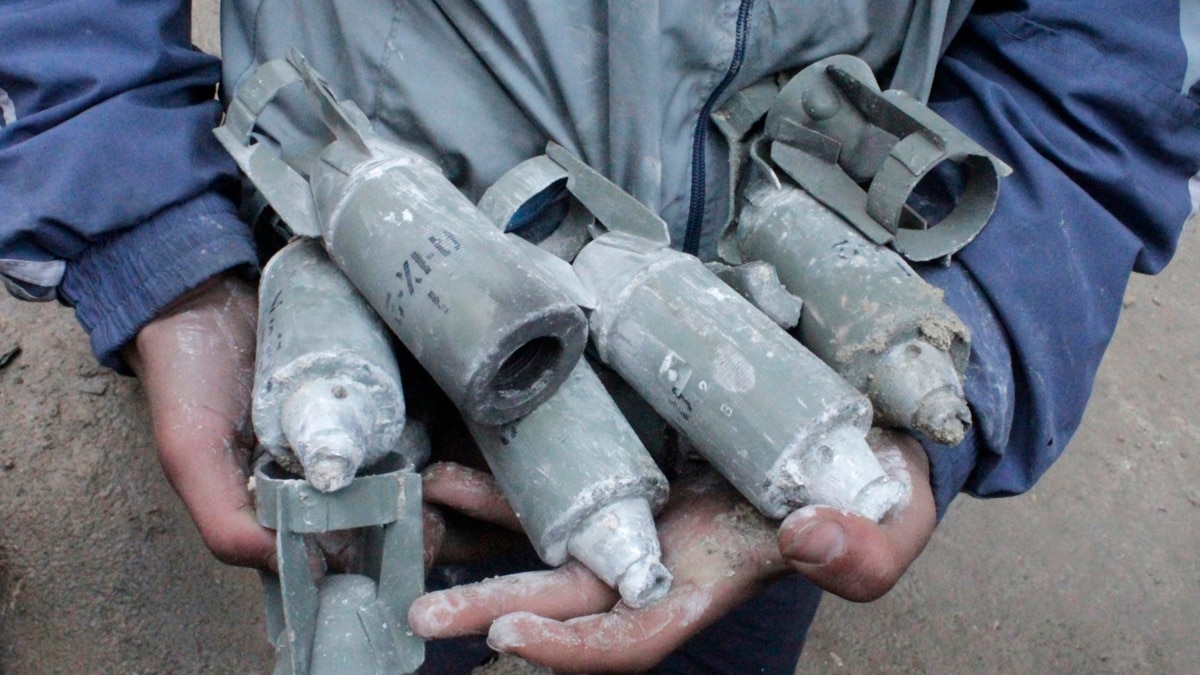News
Biden to Supply Ukraine With Banned Cluster Munitions
The US Pentagon stated Friday that it will supply cluster munitions to Ukraine for the first time, as Kyiv’s soldiers face difficult fighting in their counteroffensive against invading Russian troops.
Due to the danger that unexploded bomblets offer to civilians, the action sparked harsh criticism from rights groups, but Washington claimed it had gotten assurances from Kyiv that it would minimise harm to civilians, notably by not employing the explosives in inhabited areas.
President Joe Biden told CNN that providing the bombs was “very difficult,” but Ukrainian forces were “running out of ammunition.”
“They either have the weapons to stop the Russians now, preventing the Ukrainian offensive through these areas, or they don’t.” “And I believe they were needed,” he added.
The Pentagon claimed in a statement Friday that a new military aid package released Friday includes “dual-purpose improved conventional munitions,” alluding to cluster munitions bombs.
Ukrainian President Volodymyr Zelensky quickly expressed his appreciation for the “much-needed” assistance, tweeting that “the expansion of Ukraine’s defence capabilities will provide new tools for the de-occupation of our land and bringing peace closer.”
Massive risk of civilian harm
According to US National Security Advisor Jake Sullivan, there is “a massive risk of civilian harm if Russian troops and tanks roll over Ukrainian positions and take more Ukrainian territory and subjugate more Ukrainian civilians because Ukraine does not have enough artillery.”
“Kyiv has provided written assurances that it will use these in a very careful manner,” he added, adding that Ukraine’s government “has every incentive to minimise risk to civilians, because they are their citizens.”
Ukraine promised not to deploy the rounds in civilian-populated areas and to record where they were used to aid demining work after the war, according to US Undersecretary of Defence Colin Kahl.
The US would also not give cluster munitions with a “dud rate” of more than 2.35 percent, according to Kahl, comparing this with Russia’s 30-40 percent rate of such weapons deployed in Ukraine.
He described the Ukrainian counteroffensive as “difficult sledding, because the Russians had… six months to dig in.” As a result, the Russian defensive belts in the east and south are formidable; any military would find it difficult to breach them.”
“We want to ensure that the Ukrainians have enough artillery to keep fighting in the context of the current counteroffensive, and because things are moving a little slower than some had hoped, there are very high artillery expenditures.”
However, human rights organisations have vigorously opposed the United States sending the the cluster munitions.

Long-term suffering for civilians from cluster munitions
According to Human Rights Watch, “transferring these weapons would inevitably cause long-term suffering for civilians and undermine the international opprobrium of their use opposes.”
According to Amnesty International, Biden’s administration “must understand that any decision allowing the broader use of cluster bombs in this war will almost certainly result in one predictable outcome: the death of more civilians.”
“Cluster munitions are indiscriminate weapons that pose a serious risk to civilian lives even after a conflict has ended.” “Any country’s transfer and use of them under any circumstances is incompatible with international law,” it added.
UN Secretary-General Antonio Guterres, according to a spokeswoman, “does not want there to be continued use of cluster munitions on the battlefield.”
The US has led the international campaign for Ukraine’s backing, immediately forming an international coalition to help Kyiv after Russia invaded and coordinating aid from dozens of countries.
Since the Russian invasion in February 2022, Washington has committed to provide more over $42 billion in military aid to Kiev.
Loss in Ukraine could force collapse of NATO’ or war
Meanwhile, Ukrainian President Volodymyr Zelensky stated on Thursday that a loss to Russia could compel the United States to choose between the “collapse of NATO” or war.
“If Ukraine loses, if Russia occupies Ukraine, Russia will continue to go towards Baltic countries, Poland, and so on,” Zelensky told the Hill. “And they will start a war with one of the NATO countries, and at this point, the United States will have to choose between NATO collapse and war.”
Estonia, Latvia, and Lithuania, as well as Poland, are all NATO members. An attack on any member of the alliance is “considered an attack against them all” under the treaty organization’s collective defence principle.
In response to Republican legislators’ recommendation that the US reduce its spending on the Ukraine war, Zelensky raised the potential of NATO engagement.
Florida Gov. Ron DeSantis, a Republican presidential candidate in 2024, previously labelled the situation as a “territorial dispute,” suggesting that the United States should not become “further entangled” in it.
Last year, House Speaker Kevin McCarthy (R-Calif.) cautioned that a Republican majority would not issue a “blank cheque” to Ukraine for funding.
“Is any candidate or senator who believes it is too expensive for the United States to support Ukraine willing to go to war, fight, and send his children?” Zelensky asked on Thursday, adding, “Because they will have to do this anyway if NATO gets involved.”
“It’s not Ukraine versus Russia,” he clarified. “Russia is fighting against the civilized world.”

As the conflict against Russia has stretched on for more than a year, the United States and its allies have continued to equip Kyiv with increasingly modern weaponry. President Biden reversed his unwillingness to discuss F-16 fighter jets last month, stating the US would help an international coalition training Ukrainian pilots on the jets.
Zelensky, who has long desired fighter jets, stated in an interview on Thursday that the lengthy process of procuring such modern military weapons had “prolonged the war.”
“If we are supplied with the machinery that is currently held by our partners, we will win faster,” he added.
He did, however, appear confident that his country’s next counteroffensive, which has finally begun after months of anticipation, could lead to Russia’s defeat if successful.
“Our heroic people, our troops who are now at the front of the front line, are facing very tough resistance,” he told BBC News. “And you realise why. Because losing this campaign to Ukraine, in my opinion, means losing the war.”

How Cluster Munitions Work
More than 100 nations, including the United Kingdom, France, and Germany, have joined the Convention on Cluster Munitions, which prohibits the use or stockpiling of these weapons due to their indiscriminate effect on civilian populations.
Children are especially vulnerable since bomblets might resemble a little toy left in a residential or farming area and are frequently picked up out of curiosity.
Human rights organisations have called cluster munitions “abhorrent” and even a war crime.
Since the beginning of Russia’s full-scale invasion in February 2022, both Russia and Ukraine have used cluster munitions.
Neither has signed the treaty that prohibits them. The US has not, but it has already condemned Russia’s extensive use of the weapon.
Russian cluster munitions are said to have a “dud rate” of 40%, which means that a substantial percentage of them remain a hazard on the ground, whereas the usual dud rate is around 20%.
According to the Pentagon, the failure rate of its own cluster bomblets is less than 3%.
Ukraine’s forces are dangerously short on artillery rounds, owing to the fact that, like the Russians, they use them up at an alarming rate, and Ukraine’s Western allies are unable to replace them as quickly as they are required.
Artillery has become a critical weapon on the relatively static, grinding battlefronts of southern and eastern Ukraine.
The Ukrainians now confront a tremendous challenge in trying to evict the invading Russians from their well-fortified defensive positions along a 1,000km (621-mile) battlefront.
In the lack of sufficient artillery shells, Ukraine has requested that the United States replenish its supply of cluster munitions to target the Russian army manning all those defensive positions.
This has not been an easy decision for Washington, and it is widely opposed by many Democrats and human rights activists. The discussion has raged for at least six months.

News
Trudeau’s Gun Grab Could Cost Taxpayers a Whopping $7 Billion

A recent report indicates that since Trudeau’s announcement of his gun buyback program four years ago, almost none of the banned firearms have been surrendered.
The federal government plans to purchase 2,063 firearm models from retailers following the enactment of Bill C-21, which amends various Acts and introduces certain consequential changes related to firearms. It was granted royal assent on December 15 of last year.
This ban immediately criminalized the actions of federally-licensed firearms owners regarding the purchase, sale, transportation, importation, exportation, or use of hundreds of thousands of rifles and shotguns that were previously legal.
The gun ban focused on what it termed ‘assault-style weapons,’ which are, in reality, traditional semi-automatic rifles and shotguns that have enjoyed popularity among hunters and sport shooters for over a century.
In May 2020, the federal government enacted an Order-in-Council that prohibited 1,500 types of “assault-style” firearms and outlined specific components of the newly banned firearms. Property owners must adhere to the law by October 2023.
Trudeau’s Buyback Hasn’t Happened
“In the announcement regarding the ban, the prime minister stated that the government would seize the prohibited firearms, assuring that their lawful owners would be ‘grandfathered’ or compensated fairly.” “That hasn’t happened,” criminologist Gary Mauser told Rebel News.
Mauser projected expenses ranging from $2.6 billion to $6.7 billion. The figure reflects the compensation costs amounting to $756 million, as outlined by the Parliamentary Budget Office (PBO).
“The projected expenses for gathering the illegal firearms are estimated to range from $1.6 billion to $7 billion.” “This range estimate increases to between $2.647 billion and $7 billion when compensation costs to owners are factored in,” Mauser stated.
Figures requested by Conservative MP Shannon Stubbs concerning firearms prohibited due to the May 1, 2020 Order In Council reveal that $72 million has been allocated to the firearm “buyback” program, yet not a single firearm has been confiscated to date.
In a recent revelation, Public Safety Canada disclosed that the federal government allocated a staggering $41,094,556, as prompted by an order paper question from Conservative Senator Don Plett last September, yet yielded no tangible outcomes.
An internal memo from late 2019 revealed that the Liberals projected their politically motivated harassment would incur a cost of $1.8 billion.
Enforcement efforts Questioned
By December 2023, estimates from TheGunBlog.ca indicate that the Liberals and RCMP had incurred or were responsible for approximately $30 million in personnel expenses related to the enforcement efforts. The union representing the police service previously stated that the effort to confiscate firearms is a “misdirected effort” aimed at ensuring public safety.
“This action diverts crucial personnel, resources, and funding from tackling the more pressing and escalating issue of criminal use of illegal firearms,” stated the National Police Federation (NPF).
The Canadian Sporting Arms & Ammunition Association (CSAAA), representing firearms retailers, has stated it will have “zero involvement” in the confiscation of these firearms. Even Canada Post held back from providing assistance due to safety concerns.
The consultant previously assessed that retailers are sitting on almost $1 billion worth of inventory that cannot be sold or returned to suppliers because of the Order-In-Council.
“Despite the ongoing confusion surrounding the ban, after four years, we ought to be able to address one crucial question.” Has the prohibition enhanced safety for Canadians? Mauser asks.
Illegally Obtained Firearms are the Problem
Statistics Canada reports a 10% increase in firearm-related violent crime between 2020 and 2022, rising from 12,614 incidents to 13,937 incidents. In that timeframe, the incidence of firearm-related violent crime increased from 33.7 incidents per 100,000 population in 2021 to 36.7 incidents the subsequent year.
“This marks the highest rate documented since the collection of comparable data began in 2009,” the criminologist explains.
Supplementary DataData indicates that firearm homicides have risen since 2020. “The issue lies not with lawfully-held firearms,” Mauser stated.
Firearms that have been banned under the Order-in-Council continue to be securely stored in the safes of their lawful owners. The individuals underwent a thorough vetting process by the RCMP and are subject to nightly monitoring to ensure there are no infractions that could pose a risk to public safety.
“The firearms involved in homicides were seldom legally owned weapons wielded by their rightful owners,” Mauser continues. The number of offenses linked to organized crime has surged from 4,810 in 2016 to a staggering 13,056 in 2020.
“If those in power … aim to diminish crime and enhance public safety, they ought to implement strategies that effectively focus on offenders and utilize our limited tax resources judiciously to reach these objectives,” he stated.
Related News:
Millennials in Canada Have Turned their Backs on Justin Trudeau
Millennials in Canada Have Turned their Backs on Justin Trudeau
News
Google’s Search Dominance Is Unwinding, But Still Accounting 48% Search Revenue

Google is so closely associated with its key product that its name is a verb that signifies “search.” However, Google’s dominance in that sector is dwindling.
According to eMarketer, Google will lose control of the US search industry for the first time in decades next year.
Google will remain the dominant search player, accounting for 48% of American search advertising revenue. And, remarkably, Google is still increasing its sales in the field, despite being the dominating player in search since the early days of the George W. Bush administration. However, Amazon is growing at a quicker rate.
Google’s Search Dominance Is Unwinding
Amazon will hold over a quarter of US search ad dollars next year, rising to 27% by 2026, while Google will fall even more, according to eMarketer.
The Wall Street Journal was first to report on the forecast.
Lest you think you’ll have to switch to Bing or Yahoo, this isn’t the end of Google or anything really near.
Google is the fourth-most valued public firm in the world. Its market worth is $2.1 trillion, trailing just Apple, Microsoft, and the AI chip darling Nvidia. It also maintains its dominance in other industries, such as display advertisements, where it dominates alongside Facebook’s parent firm Meta, and video ads on YouTube.
To put those “other” firms in context, each is worth more than Delta Air Lines’ total market value. So, yeah, Google is not going anywhere.
Nonetheless, Google faces numerous dangers to its operations, particularly from antitrust regulators.
On Monday, a federal judge in San Francisco ruled that Google must open up its Google Play Store to competitors, dealing a significant blow to the firm in its long-running battle with Fortnite creator Epic Games. Google announced that it would appeal the verdict.
In August, a federal judge ruled that Google has an illegal monopoly on search. That verdict could lead to the dissolution of the company’s search operation. Another antitrust lawsuit filed last month accuses Google of abusing its dominance in the online advertising business.
Meanwhile, European regulators have compelled Google to follow tough new standards, which have resulted in multiple $1 billion-plus fines.

Pixa Bay
Google’s Search Dominance Is Unwinding
On top of that, the marketplace is becoming more difficult on its own.
TikTok, the fastest-growing social network, is expanding into the search market. And Amazon has accomplished something few other digital titans have done to date: it has established a habit.
When you want to buy anything, you usually go to Amazon, not Google. Amazon then buys adverts to push companies’ products to the top of your search results, increasing sales and earning Amazon a greater portion of the revenue. According to eMarketer, it is expected to generate $27.8 billion in search revenue in the United States next year, trailing only Google’s $62.9 billion total.
And then there’s AI, the technology that (supposedly) will change everything.
Why search in stilted language for “kendall jenner why bad bunny breakup” or “police moving violation driver rights no stop sign” when you can just ask OpenAI’s ChatGPT, “What’s going on with Kendall Jenner and Bad Bunny?” in “I need help fighting a moving violation involving a stop sign that wasn’t visible.” Google is working on exactly this technology with its Gemini product, but its success is far from guaranteed, especially with Apple collaborating with OpenAI and other businesses rapidly joining the market.
A Google spokeswoman referred to a blog post from last week in which the company unveiled ads in its AI overviews (the AI-generated text that appears at the top of search results). It’s Google’s way of expressing its ability to profit on a changing marketplace while retaining its business, even as its consumers steadily transition to ask-and-answer AI and away from search.

Google has long used a single catchphrase to defend itself against opponents who claim it is a monopoly abusing its power: competition is only a click away. Until recently, that seemed comically obtuse. Really? We are going to switch to Bing? Or Duck Duck Go? Give me a break.
But today, it feels more like reality.
Google is in no danger of disappearing. However, every highly dominating company faces some type of reckoning over time. GE, a Dow mainstay for more than a century, was broken up last year and is now a shell of its previous dominance. Sears declared bankruptcy in 2022 and is virtually out of business. US Steel, long the foundation of American manufacturing, is attempting to sell itself to a Japanese corporation.
SOURCE | CNN
News
The Supreme Court Turns Down Biden’s Government Appeal in a Texas Emergency Abortion Matter.

(VOR News) – A ruling that prohibits emergency abortions that contravene the Supreme Court law in the state of Texas, which has one of the most stringent abortion restrictions in the country, has been upheld by the Supreme Court of the United States. The United States Supreme Court upheld this decision.
The justices did not provide any specifics regarding the underlying reasons for their decision to uphold an order from a lower court that declared hospitals cannot be legally obligated to administer abortions if doing so would violate the law in the state of Texas.
Institutions are not required to perform abortions, as stipulated in the decree. The common populace did not investigate any opposing viewpoints. The decision was made just weeks before a presidential election that brought abortion to the forefront of the political agenda.
This decision follows the 2022 Supreme Court ruling that ended abortion nationwide.
In response to a request from the administration of Vice President Joe Biden to overturn the lower court’s decision, the justices expressed their disapproval.
The government contends that hospitals are obligated to perform abortions in compliance with federal legislation when the health or life of an expectant patient is in an exceedingly precarious condition.
This is the case in regions where the procedure is prohibited. The difficulty hospitals in Texas and other states are experiencing in determining whether or not routine care could be in violation of stringent state laws that prohibit abortion has resulted in an increase in the number of complaints concerning pregnant women who are experiencing medical distress being turned away from emergency rooms.
The administration cited the Supreme Court’s ruling in a case that bore a striking resemblance to the one that was presented to it in Idaho at the beginning of the year. The justices took a limited decision in that case to allow the continuation of emergency abortions without interruption while a lawsuit was still being heard.
In contrast, Texas has been a vocal proponent of the injunction’s continued enforcement. Texas has argued that its circumstances are distinct from those of Idaho, as the state does have an exemption for situations that pose a significant hazard to the health of an expectant patient.
According to the state, the discrepancy is the result of this exemption. The state of Idaho had a provision that safeguarded a woman’s life when the issue was first broached; however, it did not include protection for her health.
Certified medical practitioners are not obligated to wait until a woman’s life is in imminent peril before they are legally permitted to perform an abortion, as determined by the state supreme court.
The state of Texas highlighted this to the Supreme Court.
Nevertheless, medical professionals have criticized the Texas statute as being perilously ambiguous, and a medical board has declined to provide a list of all the disorders that are eligible for an exception. Furthermore, the statute has been criticized for its hazardous ambiguity.
For an extended period, termination of pregnancies has been a standard procedure in medical treatment for individuals who have been experiencing significant issues. It is implemented in this manner to prevent catastrophic outcomes, such as sepsis, organ failure, and other severe scenarios.
Nevertheless, medical professionals and hospitals in Texas and other states with strict abortion laws have noted that it is uncertain whether or not these terminations could be in violation of abortion prohibitions that include the possibility of a prison sentence. This is the case in regions where abortion prohibitions are exceedingly restrictive.
Following the Supreme Court’s decision to overturn Roe v. Wade, which resulted in restrictions on the rights of women to have abortions in several Republican-ruled states, the Texas case was revisited in 2022.
As per the orders that were disclosed by the administration of Vice President Joe Biden, hospitals are still required to provide abortions in cases that are classified as dire emergency.
As stipulated in a piece of health care legislation, the majority of hospitals are obligated to provide medical assistance to patients who are experiencing medical distress. This is in accordance with the law.
The state of Texas maintained that hospitals should not be obligated to provide abortions throughout the litigation, as doing so would violate the state’s constitutional prohibition on abortions. In its January judgment, the 5th United States Circuit Court of Appeals concurred with the state and acknowledged that the administration had exceeded its authority.
SOURCE: AP
SEE ALSO:
Could Last-Minute Surprises Derail Kamala Harris’ Campaign? “Nostradamus” Explains the US Poll.
-

 News3 years ago
News3 years agoLet’s Know About Ultra High Net Worth Individual
-
Entertainment2 years ago
Mabelle Prior: The Voice of Hope, Resilience, and Diversity Inspiring Generations
-

 Health4 years ago
Health4 years agoHow Much Ivermectin Should You Take?
-

 Tech2 years ago
Tech2 years agoTop Forex Brokers of 2023: Reviews and Analysis for Successful Trading
-

 Lifestyles3 years ago
Lifestyles3 years agoAries Soulmate Signs
-

 Movies2 years ago
Movies2 years agoWhat Should I Do If Disney Plus Keeps Logging Me Out of TV?
-

 Health3 years ago
Health3 years agoCan I Buy Ivermectin Without A Prescription in the USA?
-

 Learning3 years ago
Learning3 years agoVirtual Numbers: What Are They For?


